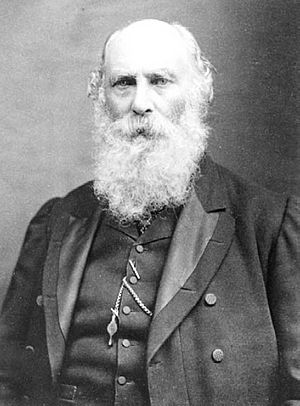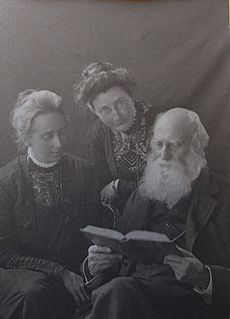George Johnstone Stoney facts for kids
Quick facts for kids
George Johnstone Stoney
|
|
|---|---|
 |
|
| Born | 15 February 1826 Oakley Park, Birr, County Offaly, Ireland
|
| Died | 5 July 1911 (aged 85) |
| Nationality | Irish |
| Alma mater | Trinity College Dublin |
| Known for | The Stoney scale, Electron |
| Scientific career | |
| Fields | Physics |
| Institutions | Queen's College Galway, Queen's University of Ireland |
| Influenced | J. J. Thomson |
George Johnstone Stoney (born February 15, 1826 – died July 5, 1911) was an Irish scientist who studied physics. He is most famous for giving us the word electron. He used this word to describe the tiny, basic unit of electricity.
He first thought of this idea in 1874, calling it "electrine." But he officially used the word "electron" in 1891. Stoney wrote about 75 science papers during his life.
Contents
Early Life and Learning
Stoney was born in Oakley Park, near Birr, in County Offaly, Ireland. He came from an old Irish family. He went to Trinity College Dublin and earned his first degree in 1848.
From 1848 to 1852, Stoney worked as an assistant to William Parsons, 3rd Earl of Rosse. Parsons had built the world's largest telescope at Birr Castle. While working there, Stoney kept studying physics and math. He earned his master's degree in 1852.
Working Life and Science
From 1852 to 1857, Stoney was a physics professor at Queen's College Galway. After that, he worked as a Secretary for the Queen's University of Ireland in Dublin. This was an office job.
In the 1880s, he became the superintendent of Civil Service Examinations in Ireland. He held this job until he retired in 1893. After retiring, he moved to London, England. Stoney passed away in 1911 at his home in Notting Hill, London.
Even with his office jobs, Stoney kept doing his own science research. He was also a leader in the Royal Dublin Society, a science group. Later, he joined the council of the Royal Society in London.
Important Science Discoveries
Stoney published 75 science papers in different journals. He made big contributions to understanding space physics and how gases work. He even estimated how many molecules are in a tiny bit of gas.
Stoney's most important work was thinking about and calculating the "atom of electricity." In 1891, he suggested the name 'electron' for this basic unit of electric charge. His ideas helped pave the way for J. J. Thomson to discover the electron particle in 1897.
Stoney did all his scientific work in his free time. A special sun-tracking device he designed is now in the Science Museum Group collection.
He became a Fellow of the Royal Society in 1861. This was because of his important papers on waves, crystals, and molecular physics.
Stoney's Units
In 1881, Stoney created the first system of natural units. He realized that a fixed amount of charge moves during electrolysis. This is called the elementary charge (e).
He combined this charge with other known universal constants. These included the speed of light (c) and the Newtonian constant of gravitation (G). With these, he could create a complete system of units. He showed how to figure out units for mass, length, time, and electric charge.
Later, another scientist named Planck also created a similar system of natural units.
Stoney's Family
Stoney married his cousin, Margaret Sophia Stoney. They had two sons and three daughters. For many years in Dublin, Stoney lived in the Dundrum, Dublin area. The street he lived on was later named Stoney Road to remember him. After he died in London, his ashes were buried in St. Nahi's Church in Dundrum.
One of Stoney's sons, George Gerald Stoney, also became a scientist. His daughter Florence Stoney was a radiologist. His other daughter, Edith, is known as the first woman medical physicist. Stoney's nephew, George Francis FitzGerald, was also a famous physicist in Dublin.
His brother, Bindon Blood Stoney, was an engineer.
Lasting Impact
In 1902, the University of Dublin gave Stoney an honorary Doctorate of Science degree.
Stoney and his nephew FitzGerald often talked about science. They also shared similar political views. They both did not support the Irish Home Rule Movement. They believed this movement went against the spirit of science. Stoney even left his job at Queen's University in 1882. He disagreed with a government decision that he felt brought religious differences into the university system.
In 1902, he was chosen as a member of the American Philosophical Society.
Two craters are named in his honor. One is on Mars and the other on the Moon.
See also
 In Spanish: George Johnstone Stoney para niños
In Spanish: George Johnstone Stoney para niños
- Basic concepts of quantum mechanics
- Planck units
- Stoney units


